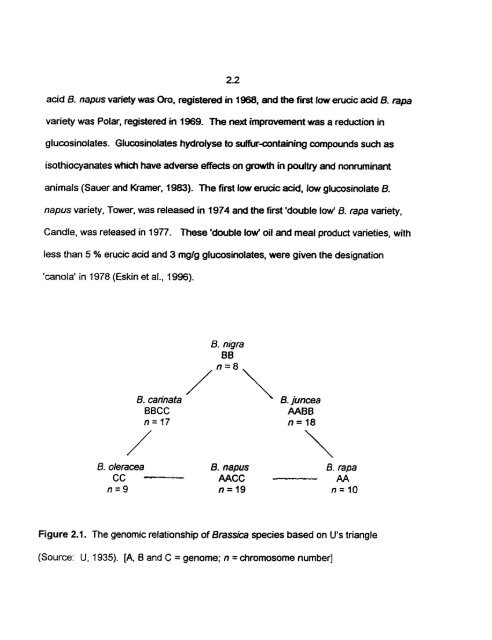The Application of Ooubled Haploid Plants to Population ... - MSpace
The Application of Ooubled Haploid Plants to Population ... - MSpace
The Application of Ooubled Haploid Plants to Population ... - MSpace
Create successful ePaper yourself
Turn your PDF publications into a flip-book with our unique Google optimized e-Paper software.
2-2<br />
acid B. napus varÏety was Oro. registered in 1968, and the first low enicic acid B. tapa<br />
variety was Polar, registered ni 1969. <strong>The</strong> next Rnprovement was a redudion in<br />
glucosinolates. Glucosinolates hydrolyse <strong>to</strong> suîfkjr+zontaining compounds such as<br />
isothiocyanates which have adverse effects on growth in poultry and nonruminant<br />
animals (Sauer and Krarner, 1983). <strong>The</strong> first low enicic acid, low glucosniolate 6.<br />
napus variety. Tower, was released in 1974 and the first 'double low' B. rapa variety,<br />
Candle. was released in 1977. <strong>The</strong>se 'double IoW oil and meal produd varieties, with<br />
less than 5 % erucic acid and 3 mglg glucosinolates, were g iven the designation<br />
'canola' in 1978 (Eskin et al., 1996).<br />
S. nigra<br />
BI3<br />
BBCC<br />
n=f7<br />
AABB<br />
n=18<br />
B. deracea B. napus 8. rapa<br />
CC AACC AA<br />
n=9 n=19 n=lO<br />
Figure 2.1. <strong>The</strong> genomic relationship <strong>of</strong> Brassica species based on U's triangle<br />
(Source: U, 1935). [A, 8 and C = genome; n = chromosome number]







![an unusual bacterial isolate from in partial fulf]lment for the ... - MSpace](https://img.yumpu.com/21942008/1/190x245/an-unusual-bacterial-isolate-from-in-partial-fulflment-for-the-mspace.jpg?quality=85)





![in partial fulfil]ment of the - MSpace - University of Manitoba](https://img.yumpu.com/21941988/1/190x245/in-partial-fulfilment-of-the-mspace-university-of-manitoba.jpg?quality=85)


